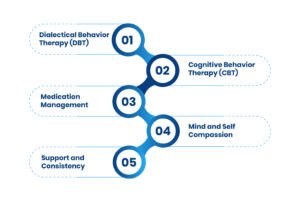When it comes to borderline personality disorder (BPD), the thought process is usually full of emotional explosions, emotional swings, and hasty choices. Nevertheless, Quiet Borderline Personality Disorder (Quiet BPD) appears entirely different. Individuals who have Quiet BPD hold back their feelings rather than expressing them. They can look peaceful, but in their hearts, they are grappling with inner suffering, fear, and self-doubt.
Interestingly, Quiet BPD conceals himself behind the silence, smiles, and overthinking. Most of the population is unaware of the fact that they are living with it until the emotional pressure is too weighty. Thus, it is essential to learn about this type of BPD to recognize and help them as soon as possible. This article describes the meaning of Quiet BPD, its symptoms, causes, effects on relationships, and treatment.
What Is Quiet BPD?
Quiet Borderline Personality Disorder is a BPD in which an individual directs the pain of the emotion inward. They do not vent their anger or frustrations towards other people, but towards themselves. Therefore, they tend to look composed and collected, yet their minds are full of negative thoughts of guilt and fear.
In addition, an individual having Quiet BPD experiences powerful emotions but conceals them, not to be rejected or judged. They can remain silent when offended, pin themselves after quarrels, or isolate themselves. So, this is emotional regulation that renders Quiet BPD difficult to identify since the struggle occurs in secret.
Moreover, individuals who suffer from Quiet Borderline Personality Disorder generally fight loneliness, emptiness, and self-reproach. They desire to relate with other people but are afraid of expressing themselves, as it may make people go away.
Quiet BPD Symptoms
Quiet BPD signs are usually under the radar, and hence, this condition is hard to diagnose. People suppress their emotions and do not express them loudly.
- Self-blame: The individual takes blame for all mistakes or conflicts.
- Emotional withdrawal: When they are hurt, they withdraw.
- Perfectionism: They attempt to appear flawless to ensure that other people do not shun them.
- Internal anger: They direct anger towards themselves, and this makes them feel guilty or criticize themselves.
- Emotional numbness: They close off their emotions in the event they are overwhelmed.
- Chronic emptiness: They experience emptiness or disconnection even when not in stress.
- Quiet BPD meltdown: They melt down alone, crying or isolating themselves.
Consequently, they can be perceived by others as either shy, polite, or too cautious, but in their heart, they are undergoing emotional storms that no one pays attention to.
BPD Triggers and Quiet BPD Symptoms
The causes of BPD triggers are overwhelming in the way that they provoke emotional responses. Common triggers include:
- Feeling sad or left out
- Relationship conflicts
- Fear of failure or disapproval.
- Unmet emotional needs
When triggers come out, the individual can have a quiet BPD meltdown, which is an emotionally silent, self-accusing, or avoidant period. Hence, the identification of triggers helps individuals acquire coping mechanisms and prevent emotional shutdown.
What Causes Quiet BPD?
Many factors cause Quiet Borderline Personality Disorder. The factors usually comprise a combination of genetic factors, childhood experiences, and personality traits.
- The presence of mental health problems in relatives increases the probability of developing BPD.
- Some individuals are more sensitive to emotions and would find it difficult to control their emotions.
- To live in an atmosphere of regular criticism or unpredictability educates one to conceal feelings.
As an example, a child who gets to know that the expression of feelings causes punishment or rejection will become an adult who holds back. This emotional suppression, as time goes by, becomes Quiet BPD behavior.
Quiet BPD and Romantic Relationships
Quiet BPD and romantic relationships may be dramatic but delicate. Quiet BPD people desire emotional attachments, fear losing them. Thus, they can be distanced although they want to be close. This emotional pull and push cause confusion to both partners. The typical relationship patterns are:
- The overthinking of each message or action of a partner.
- Eschewing confrontations by being quiet.
- Switching between idealizing and doubting the partner.
Once such a favorite person pays less attention or care, it may cause severe panic or depression. As a result, such a person can withdraw, ruminate, and lose their worth to love. It is despite these struggles that individuals with Quiet BPD can have positive relationships, emotional awareness, and communication.
Is Quiet BPD Real?
Yes, Quiet Borderline Personality Disorder is a fact and real to some extent. Mental health professionals have accepted it as an acceptable manifestation of BPD characteristics. Even though the DSM-5 does not make it one diagnosis, professionals use the term quiet to refer to the inward nature of emotional pain.
Additionally, Quiet BPD shows an equal level of emotion as typical BPD. The difference is, however, in how they manage it. They conceal anger instead of expressing it. They do not contact, rather pull back.
Regrettably, their symptoms are misunderstood by many people as depression or anxiety. This misunderstanding slows down the treatment. Hence, the understanding of Quiet BPD can make individuals seek proper treatment and start the healing process at a young age.
Quiet BPD Vs Covert Narcissism
At first glance, Quiet BPD and covert narcissism may look similar because both involve low self-esteem and hypersensitivity. However, their emotional roots differ significantly.
| Quiet BPD | Covert Narcissism |
| Deep fear of abandonment and rejection. | Hidden sense of superiority and insecurity |
| Internalizes anger and pain; avoids conflict. | Appears humble but seeks validation and admiration. |
| Overthinks, withdraws, and fears being a burden. | Manipulates subtly to gain attention or control |
| Blames self, feels worthless, and withdraws. | Plays the victim or reacts with passive aggression |
| Self-isolation, self-blame, or people-pleasing. | Passive control, guilt-tripping, or emotional withdrawal. |
Clearly, a person with Quiet BPD cares deeply about others but struggles to express emotions safely. In contrast, a person with covert narcissism seeks admiration and control. Understanding these differences allows mental health professionals to choose the right treatment plan.
Quiet BPD Treatment

1. Dialectical Behavior Therapy (DBT)
DBT is the instruction on emotion control, mindfulness, and distress tolerance. As such, it would cause people to learn to cope with triggers, deal with meltdowns, and vent emotions in a safe manner.
2. Cognitive Behavior Therapy (CBT)
CBT will help one transform their negative thinking into realistic thinking. It gets rid of guilt, perfectionism, and self-criticism, where the individual then becomes emotionally balanced.
3. Medication Management
The physician can prescribe antidepressants or mood stabilizers to reduce depression or anxiety, which is usually related to Quiet BPD. Therapy, however, is best with medications.
4. Mind and Self-Compassion
Mindfulness encourages emotional non-judgment. Similarly, self-compassion creates self-acceptance and reduces emotional suffering.
5. Support and Consistency
A properly developed support system helps in recovery. Regular counseling and workout routines promote emotional and self-growth in the long run.
Quiet BPD Test
A Quiet BPD test will make you realize whether your emotions and behaviors fit this condition. These examinations usually focus on emotional patterns, self-image, and fears. They enable you to realize potential danger and take a step.
However, only online tests can lead you. A competent mental health specialist will be able to assess your symptoms and develop an individualized, quiet BPD treatment regimen. Timely assistance enhances emotional awareness and builds resilience.
Final Thoughts
The Quiet Borderline Personality Disorder conceals itself under a faced of calm behavior and friendly smiles, but the emotional pain is ever-present. Individuals who experience Quiet BPD tend to self-blame, avoid confrontations, and suppress feelings to save relationships.
Notably, the identification of Quiet BPD is the initial step towards recovery. Through quiet BPD treatment, self-awareness, and humane care, people can release emotions in constructive ways, develop closer ties, and exist peacefully.
Likewise, early intervention may alter the trend of recovery and open up a stable and satisfying life. To get more information and details about mental health and its related issues, you can get assistance and information from Mental Behavioral. You can get personalized support and advance insights to help improve your mental well-being.
FAQs
How does Quiet BPD differ from typical BPD?
Quiet BPD makes the emotional pain inward, whereas typical BPD manifests this pain in an outward manner through outbursts or impulsive behavior.
What are the questions to determine whether I have Quiet BPD?
You could also have Quiet BPD since you fear rejection, blame yourself frequently, and conceal emotional pain. To be sure, you can do a Quiet BPD test and discuss it with a therapist.
Is Quiet BPD curable through therapy?
Therapists use therapy to assist individuals in coping with the symptoms and enhancing relationships. The consistency of treatment can help many people with Quiet BPD lead balanced and happy lives.
What is the precipitating factor of Quiet BPD?
Causes are rejection, criticism, or being ignored. The effects of these experiences can be emotional withdrawal and self-criticism.
What is the meaning of Quiet BPD’s favorite person?
It has the meaning of getting emotional closeness with the other individual and relying on them to provide emotional stability. Their attention is easily lost, and this is distressing.
Is medication effective in Quiet BPD?
Yes, anxiety or depression, which usually accompany Quiet BPD, can be alleviated by medication, but the most effective method of treatment is therapy.
What can I do to help a person with Quiet BPD?
Listen without judging, reassure, and remain consistent. Promote treatment and remind them that they need to feel.








